Curious Banaban Dance: Te Karanga
"The Most Curious Dance I Have Ever Seen"
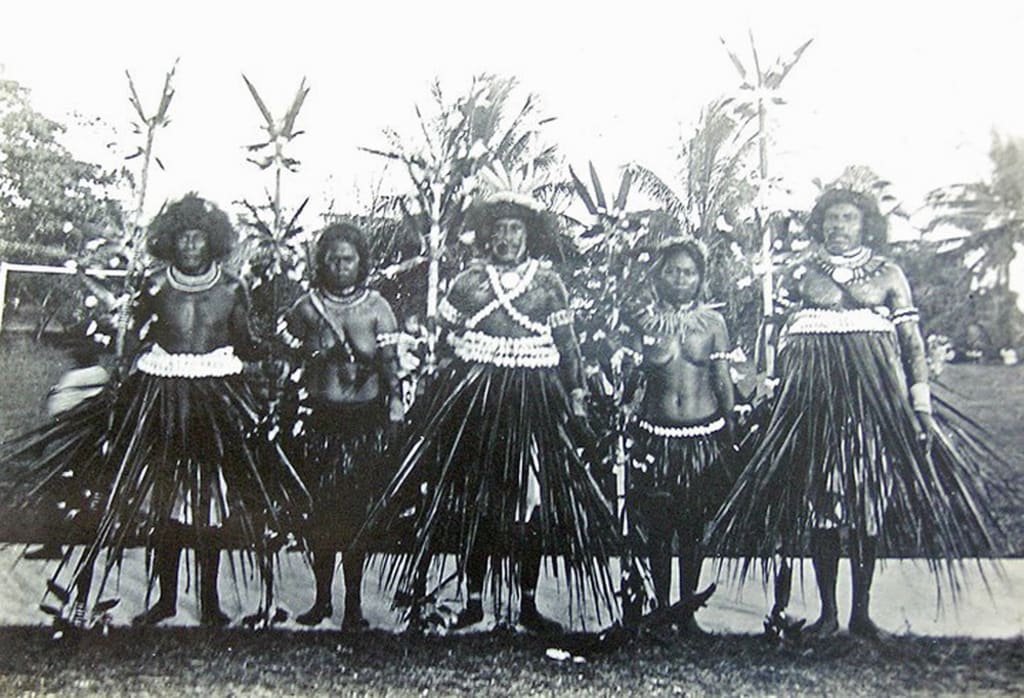
Firsthand Account of te karanga, spear dance, Ocean Island (Banaba) in 1896 and published 1908 [1] by Arthur Mahaffy, British Colonial Official.
Arthur Mahaffy’s First visit to Ocean Island, “Panapa” [Banaba] [2] in 1896
Arthur Mahaffy’s first visit to the island was only for a very short time when he landed at the village of Uma and found it occupied by a purely native community. He recalls,
“I little thought as I walked about among the curious natives, followed by a troop of delightful-looking clamorous children, that under my feet lay wealth beyond the dreams of avarice, and that in thirteen years’ time I should again visit the island, to find railways, electric light, and telephones installed, and to see four or five 6000-ton steamers waiting to carry away the very ground on which I stood”.
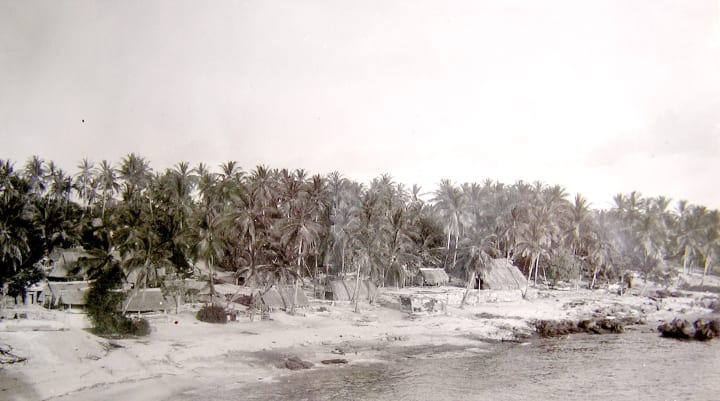
“The Most Curious Dance I Have Never Seen Elsewhere …”
Mahaffy’s’ observations and written recording of early Banaban dancing is from his second visit to the Island in 1908 and provides valuable insight into the unique Banaban dance called te karanga, spear dance. It is interesting to read Mahaffy’s very early account of this dance that is still part of Banaban tradition. Unfortunately, the original Banaban dialect in the chants have virtually been lost and only a few words remain today.
“There is one very curious and beautiful dance, which I have never seen elsewhere. The performers are drawn up in two lines facing each other, and each dancer is equipped with a staff about six feet long, decorated with feathers and coloured streamers. A long recitative is sung by the leader at the completion of which the two lines of dancers engage in a most complicated set of figures, passing in and out through the spaces between the performers with wonderful precision. As each man passes his neighbour, he raises his staff above his head and clashes it against the next one in absolute unison. The effect is very fine, and figure follows figure in great variety, always preceded by the chanting of a recitative. The dress of the dancers is also peculiar: they were upon their heads conical caps woven on coconut leaves, and from their waists, almost to the ground, hang petticoats made of the same leaf. They have necklaces of shells and flowers and are profusely anointed with coconut oil”.
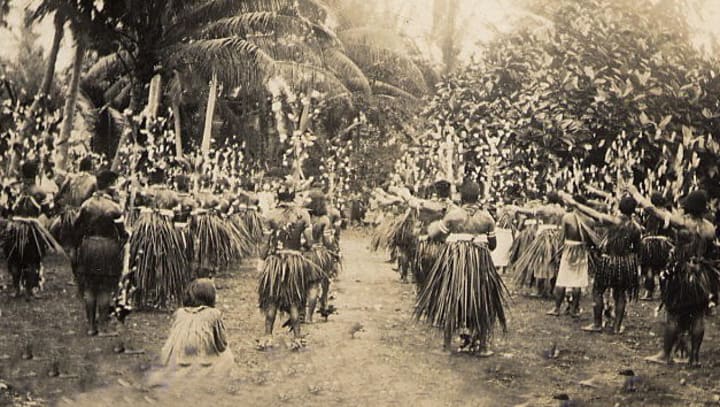
“Anointing the Dances …”
What Mahaffy was not aware of during the time of his observations is that the anointing of the dances is an important part of the ritual and the way for the Banabans to evoke spiritual powers for the dancer’s performance.
“During a pause in the dance, the women who are not themselves taking part in it bring bottles of oil, which they pour over their husbands, brothers, or friends in the most liberal way. This is a form of extravagance which 'places' the anointers and anointed as among the richest of the population. It is often overdone for the sake of ostentation, and I am sorry to say that quarrels long and bitter have arisen over the liberal or marked oiling of a gentleman by a lady to whose attentions some other member of the male chorus considered that he had a stronger claim”.

Storytelling through Dance in Language Unknown to Islanders
Storytelling and retelling of historical events has been a tradition of Banaban dancing and has been passed down through the generations and can still be found in Banaban dance performances today. Mahaffy’s reference of a graceful series of sitting dances with words unknown to the performers at the time. Could this be the lost Banaban language he is referring to?
“There is also a very graceful series of dances in which the performers are seated, and in which the waving movement of the hands is the remarkable feature. The texts of the songs which accompany these dances are for the most part unintelligible to the present race of islanders and seem to be often the mere repetition of sonorous [3] words without any meaning at all. Improvisation is, however, not rare, and the current events on the island and the peculiarities of natives, or of white men, provide the subject for many dances. Some few there are which are obscene, but they are not many, and the whole performance is very harmless”.
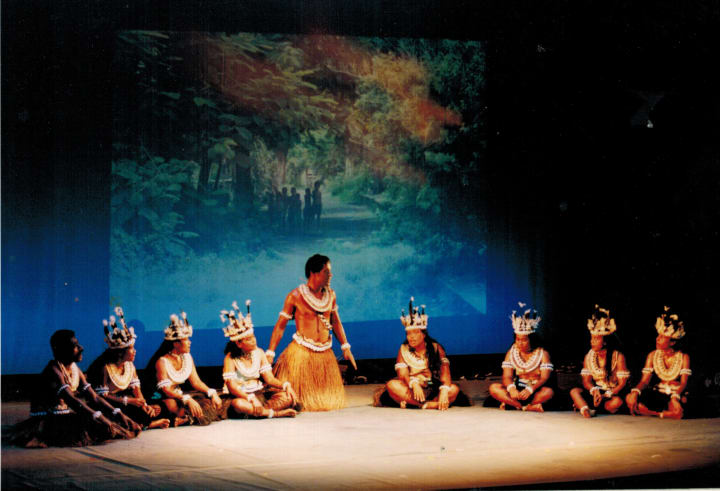
The Banaban Dance Costume Hand Ornament
“One peculiarity of these dancers I have remarked. A small ring of fibre is fastened to the fourth finger of each hand and is carded out into a kind of fan-shaped tuft at the spot where the seal would be on one of our rings. The tuft rises at right angles with the fingers, to the height of two or three inches, and the perpetual quivering motion of the hands, which is essential in all these dances, agitates the tuft of fibre very much as a butterfly, lighting on a flower, moves his closed wings. I could not find that the decoration was known to the natives as a conscious imitation of it, but I very strongly suspect that its origin may be traced to it”.
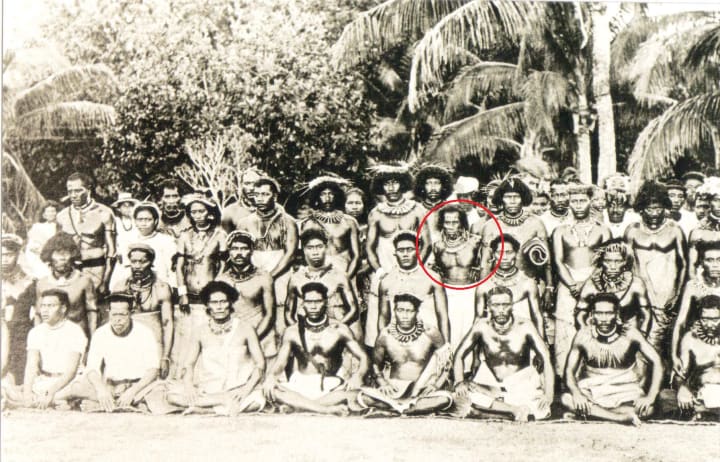
Te Tiakaunga, the Banaban Dance Conductor
“Of one native dancer I retain the liveliest remembrance. He was a hunchback, the only one I think on the island, but his agility was wonderful, and he led and directed all the more elaborate measures. He was also a humorous person, and his improvisations always provoked shouts of laughter. During the dance he was as one possessed with the spirit of perpetual motion, he was never still for a moment, and his enjoyment was delightful to see. In everyday life he was a quiet, reserved little man, but at a dance he became transfigured. Never gnome or kobold [4] skipped around a Northern Fairy Ring with more delight or with more delicate skill”.
The Banaban character mentioned by Mahaffy is well known as a Banaban te tiakaunga, dance conductor and he can be seen in one of the historical dance group photographs taken in the early 1900s.
The performance of the te Karanga lives on as part of Banaban tradition today.
The tradition of te karanga dance lives on. Banaban performing at the Opening Ceremony 2003 South Pacific Games- Fiji
___________________________________
First published: Banaba Vision
Excerpts: OCEAN ISLAND, November 1910, Blackwood’s Magazine
[1] Arthur Mahaffy (1869-1919). A British colonial official made an inspection visit to the Gilbert and Ellice Island protectorate to review economic and social conditions. Mahaffy’s eight-page report was submitted to the Office of the High Commissioner for the Western Pacific in Suva Fiji. This Article relating to OCEAN ISLAND, published Blackwood’s Magazine, 1910.
[2] Panapa; Paanopa; was the old name Banaba island was known by whaling, trading and blackbirding ships prior to the discovery of phosphate in 1900. The name is the phonetic spelling of Banaba as there is no ‘p’ in the Banaban language and it translates to the ‘b’ sound in English.
[3] Sonorous: A person's voice or another sound imposingly deep and full. Capable of producing a deep or ringing sound. Of a speech or style using imposing language.
[4] The kobold (occasionally cobold) is a sprite or fairy stemming from Germanic mythology and surviving into modern times in German folklore
Get the Book!
Read more about the epic history of Banaba (Ocean Island) and the Banaban people (The Forgotten People of the Pacific) as they try and seek justice to save their island, their culture, their future, "Te Rii ni Banaba- backbone of Banaba" by Raobeia Ken Sigrah and Stacey M King, available on Amazon here.
About the Creator
Stacey King
Stacey King, a published Australian author and historian. Her writing focuses on her mission to build global awareness of the plight of the indigenous Banaban people and her achievements as a businesswoman, entrepreneur and philanthropist.






Comments
There are no comments for this story
Be the first to respond and start the conversation.